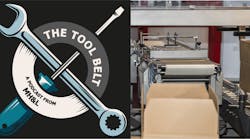Thanks to the rise of ecommerce, heightened customer delivery demands, and labor shortages, companies are increasingly turning to automation as a way of staying competitive. But how do you know where to start? Where exactly are the most crucial pain points in a supply chain that would result in the best results from an automation strategy?
In this episode of Supply Chain Insider (part of Endeavor Business Media's Tool Belt podcast series), we talk to Sean Webb, director of sales and operations for Sparck Technologies, who shares his insights on why and how companies should look into automating their packaging process. He discusses the challenges companies are facing in the transition to an ecommerce-driven marketplace, and why it's smart to focus on increasing productivity through automation. Drawing on his financial background, he also shares the ROI of automation, and answers the question: How does a company know it's the right time to automate?
This episode is sponsored by Sparck Technologies.
MH&L: Welcome to this edition of Supply Chain Insider.
We're talking today with Sean Webb. Sean is the director of sales and operations for North America with Sparck Technologies.
So first of all, welcome Sean.
Sean Webb: Thanks, Dave. I appreciate you having me today.
MH&L: Absolutely. And we appreciate your taking some time to talk with us.
If you could just give our listeners a brief overview of what exactly Sparck Technologies does and your role there, then we can get started with some questions.
SW: Sparck Technologies is a leader in automated packaging and what we do is create a right-sized box dynamically. As items are placed onto our system, we automatically scan those in and right-size them.
In this day and age of high productivity needed in warehouses and fulfillment, our system allows for a very flexible box that can be created on demand. It can create that right-sized box, and it can create all kinds of efficiencies in the operations process and create a lot of sustainability initiatives that companies are looking for.
MH&L: Thanks. So what we do with our guests here on Supply Chain Insider, is we take a look at the supply chain from their perspective and certainly, Sean, your perspective is going to be different from some of the other people that we've talked to in previous podcasts. And that's great because we want to create through the process of the podcast a bigger picture of what is going on out there in the world of supply chain.
So Sean, from your perspective – not necessarily the entire world’s, but from Sparck’s and your perspective – what do you see as being some of the biggest challenges that companies are seeing in their supply chains?
SW: What we've seen in the last few years is a large transition to an e-commerce type of environment where customers are getting very comfortable pointing and clicking and ordering online. This has created a necessity for the whole supply chain process to change how they've done it historically.
It's created a lot of demands that fluctuate quite a bit and, as we've seen, it creates that need for automation in the other dynamic that plays into – that being the changes in the labor market that have occurred, starting with an e-commerce type of environment along with the pandemic and some of the different challenges that were created there. And it's created a whole different environment for finding the labor needed to meet the demands of the customers and the fulfillment process.
So some of the challenges we're seeing out there is moving from something that was a very manual process to an automated one that's more efficient and able to keep up with those demands of this new environment.
MH&L: That leads to a natural follow-up question, which is how are companies dealing with those labor issues? Is it as simple as just saying, “I can't find enough good workers, so I'll buy some equipment”? How do companies deal with situations where they can't get enough good people to stay with them?
SW: This is what we're seeing right now. Obviously [companies] are looking for that labor and in all different parts of the warehouse.
But specifically in the packaging area, it's one of those areas that has seen little automation over the years.
People have focused on automating the picking and other processes upstream and that labor demand is happening in the packaging area and they go to a lot of different, let's call it tactics, to try to attract employees.
And that's also having an effect by raising the cost of that labor.
So as [companies] do that and try to stick with the same model that they've used over the years, it's amplifying the problem, if you will. So they're turning now to automation and they're really looking to be creative in finding whatever solution they can.
And in the end, as they look at it and understand what their application looks like, there are different automation solutions that will probably best fit their needs as they move forward.
In trying to address not only the cost of the labor as it's going up, but also the flexibility as things go up and down, they're able to have that flexibility with the automation.





